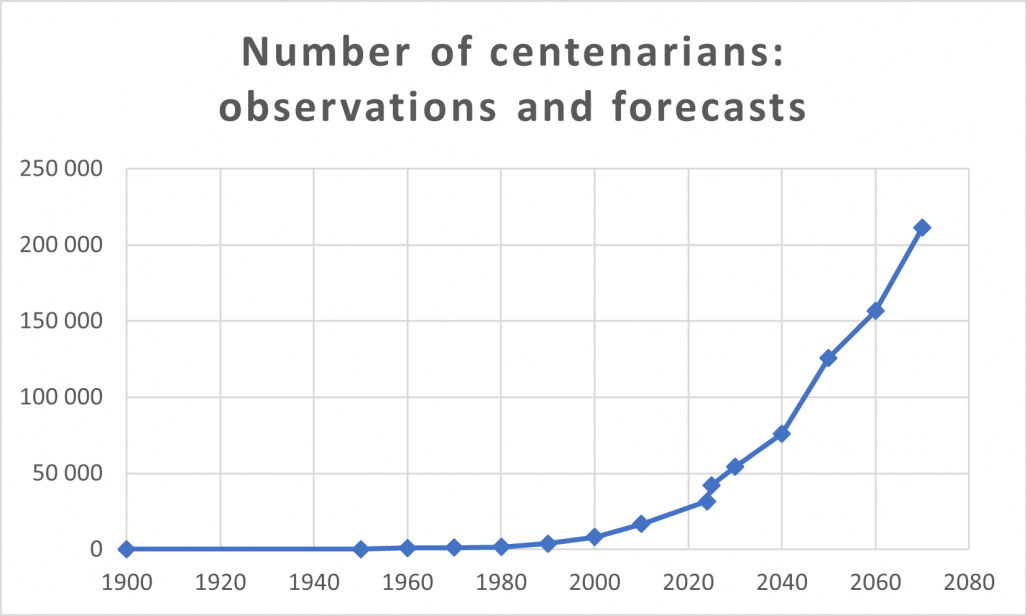The inexorable rise of centenarians and supercentenarians
Until the mid-20th century, centenarians appear to have been extremely rare. Very high infant mortality, along with a high risk of death across the lifespan, quickly decreased the numbers of surviving members of each generation. Only a tiny fraction could hope to live to age 90, let alone 100. However, with the remarkable mortality decline among children and young adults across Europe in the 20th century, then at advanced ages in the last decades of the century, the size of the oldest age groups has expanded rapidly.
Whereas only 0.02% of individuals born in 1850 lived to age 100, the proportion for those born in 1920 was 2%. The likelihood of living a century or more was thus multiplied by a factor of 100 in the interval. The increase in the number of centenarians since the end of the Second World War has been spectacular. From above 1,000 in France in 1970, their number grew to over 8,000 in 2000, and over 31,000 on 1 January 2024. Assuming that current mortality trends continue, INSEE projects that there will be more than 200,000 centenarians in France in 2070 (Blanpain 2023).

Growing numbers of deaths beyond age 105… most of them women
Within the expanding group of centenarians, recent years have seen the establishment of a new, even more long-lived group of people aged 105 or over (Vallin and Meslé, 2024). While representing a minute fraction of the over 600,000 deaths recorded annually in France (under 0.15%), their number has surged in recent years, rising from just a handful of individuals in the late 1980s to 924 in 2020.
The vast majority of people who die at age 105 or above are women (843 women and 81 men in 2020, or 10 times more women). This impressive ratio is entirely due to excess male mortality, which operates throughout the lifespan, particularly at working ages, and which correspondingly decreases the size of male cohorts in comparison to their female counterparts.
The profile of supercentenarians
People who reach their 110th birthday are known as ‘supercentenarians’. While living beyond this age is still a rare event, it has become much more frequent in recent decades. In 2022, 39 people died at age 110 or above, of whom the overwhelming majority -38 out of 39- were women.
At the department level in metropolitan France, the ratio of deceased supercentenarians to the total population ranges from 0 to 17 per million inhabitants, but with no clear geographical pattern. The overseas departments of Guadeloupe and Martinique, with 44 and 36 supercentenarians per million inhabitants, respectively, stand out clearly from the rest of France, however. Proportionally, there are nearly eight times more supercentenarians in Guadeloupe and Martinique than in metropolitan France (Vallin 2021).
The limits of human life are constantly being pushed back
Does this mean that life span is increasing? Some research supports the idea that mortality rates are essentially constant beyond the age of 105.
The existence of such a plateau meant, according to those authors, that after 105 years of life, mortality rates ceased being dependent on age. This in turn would seem to imply that there were no strict limits on human longevity, as the highest observed age values would depend only on the number of people reaching the plateau age.
But a recent study by Ined suggests, on the contrary, an increase in mortality rates beyond the age of 105, with no evidence of a mortality plateau (Dang, Camarda, Meslé and al., 2023).
It may be that the maximum limit of human life has not changed (while remaining unknown to us) and that the increase in the number of centenarians is simply a mechanical result of rising life expectancy due to advances in healthcare. The higher the number of persons living to age 90, the greater the chances are that part of the population will reach age 100. The spectacular rise in life expectancy in the twentieth century was due primarily to falls in infant and young adult mortality. It was only in the second half of the century, and especially after 1970, with advances in the struggle against cardiovascular diseases, that mortality among older persons began to fall, accelerating population ageing and radically improving chances of reaching age 100 (Vallin and Meslé 2001). On the hypothesis that the regular decline in mortality will continue, 11% of the children born in 2000 could reach 16% of the girls, 4% of the boys.
Sources :
Living beyond age 105: When the improbable becomes reality, France Meslé, Jacques Vallin, Carlo-Giovanni Camarda et al., Population et Sociétés, n° 621, 2024
30,000 centenarians in France in 2023, nearly 30 times more than in 1970, Nathalie Blanpain, Insee Première, n° 1943, avril 2023
The question of the human mortality plateau: Contrasting insights by longevity pioneers, Linh Hoang Khanh Dang, Carlo Giovanni Camarda, France Meslé et al., Demographic Research, 48(11), 2023
Investigating the eightfold difference in supercentenarians in the French West Indies compared to metropolitan France, Jacques Vallin, Gérontologie et Société, 43(166), 2021
Living beyond the age of 100, Jacques Vallin et France Meslé, Population et Sociétés, n° 365, 2001
Contact: France Meslé, Carlo Giovanni Camarda
Online: April 2024

